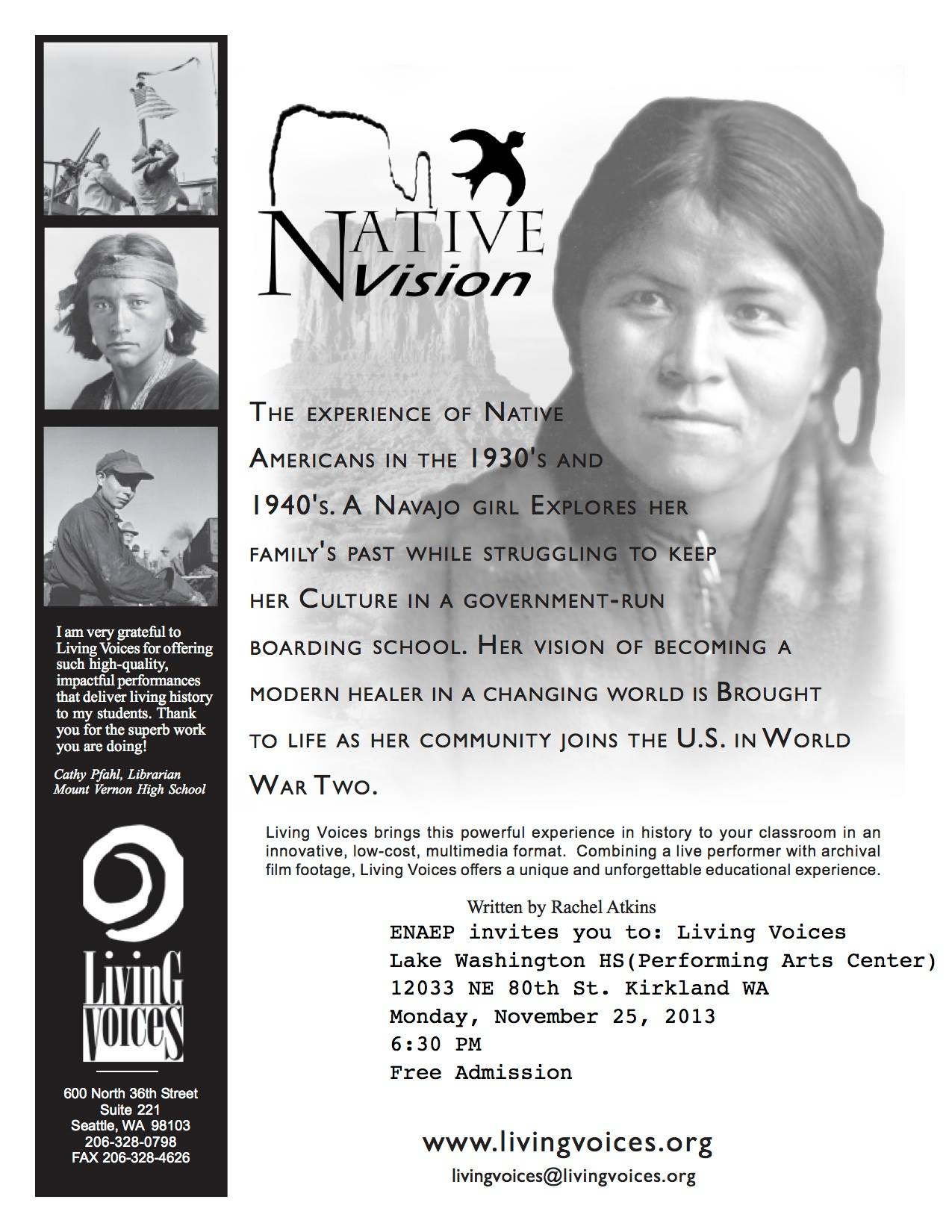Wednesday’s temps — High: 44° / Low: 35° www.king5.com/weather
Living Voices at Lake Washington High School
Time to plant! ’Tis the season for bulbs and shrubs

Photo by Terren
By Polly Keary, Editor, The Monroe Monitor
With leaves off the trees and gardens dormant, it might not seem like the time to plant anything.
But nothing could be further from the truth.
An array of packets of bulbs fills a large display at Pine Creek Nursery. Now is the time to get bulbs in the ground for a colorful early spring garden.
Photo by Polly Keary
In fact, to ensure a beautiful and healthy display in your yard next spring, or to keep your yard as lively as possible through the winter, head to local nurseries and pick up shrubs, trees and bulbs and get them in the ground.
“It’s the number one time to plant, because you are getting them in the ground where they get rained on all winter,” said Gwen Sayers at Pine Creek Nursery in Monroe, which has a wide variety of shrubs on the premises right now. “They don’t get stressed by heat, and they get all winter and spring to get established and get roots.”
Among the shrubs that are good to plant right now are evergreens, cypress, Japanese holly, juniper, cedar and weeping evergreens.
Also, flowering kale is actually at its brightest and most vivid in the winter months.
“Kale does great,” said Sayers. “It’s ornamental. They don’t grow a lot in spring and summer. They develop their color from the cold.”
Just because it’s winter doesn’t mean that you can’t have container gardens. In fact, they can do a lot to liven up patios and corners in the colder months.
“That’s something we love to do is do planters with evergreen and things like kale,” said Sayers. “A lot of that stuff will go into the summer, because it’s perennial.”
In the summer, you can plant annual flowers around a central perennial, and the perennial will still be there through the winter.
Another plant that is nice in winter container gardens, as it’s not hardy enough to be in the ground through a cold winter, is lemon cypress, a bright green-gold shrub that forms into low bushes.
Also right now is the time to plant your bulbs for early spring displays.
Garden stores everywhere are stocked up on tulips, crocus, hyacinth, daffodils and other bulbs right now, and perusing the colorful aisles planning next year’s garden-scape can be a lot of fun on a rainy afternoon.
Dave Chappelle Show of Love For Ojibwe Rapper Tall Paul
 Source: Indian Country Today Media Network
Source: Indian Country Today Media Network
For a hip hop artist, getting noticed by Dave Chappelle is no small thing. The brilliant standup and sketch comedian who’s been more or less M.I.A. since his Comedy Central series finished its run in 2006 has always been an advocate for rap artists he likes, and often featured live hip hop performances on his show. Chappelle is currently performing some gigs in Minneapolis, home turf of rapper Tall Paul, and last Monday he was alerted to the existence of one of Indian country’s most promising rhymers. The exchange occurred after Chappelle had joked with two Native American audience members. Then, as described by Vita.mn:
When one of them told them there’s a Native American rapper in the Twin Cities making a name for himself, Tall Paul, he responded, “Minneapolis be putting out the wildest rap records: Brother Ali, Tall Paul… .” Amazed by the latter’s story, he commented, “If he really can rap, I’ll sign him up for a million dollars. But he better be more than 5’7”, or I’m gonna be pissed. … And he better have better rhymes than just ‘Tall’ and ‘Paul.’”
The following night, Tall Paul showed up at the club, CD in hand to give to Chappelle. But it turned out to be unnecessary. Tall Paul says Chappelle “mentioned that he had downloaded my album. He surprised me when he mentioned ‘Protect Ya Spirit.’ So apparently he got his hands on my music before I could even get a CD to him.”
Paul (born Paul Wenell, Jr.), Leech Lake Ojibwe, said that he’s had trouble getting coverage in the local press, despite having a strong following. Whether Chappelle’s shout-out will raise his profile remains to be seen, but it can’t hurt.
Read more at http://indiancountrytodaymedianetwork.com/2013/11/19/comedian-dave-chappelle-checks-out-ojibwe-rapper-tall-paul-152314
World’s Oldest Animal Nearly as Old as Columbus Landing
 Source: Indian Country Today Media Network
Source: Indian Country Today Media Network
In a major scientific faux pas, scientists have discovered that they not only killed the world’s oldest creature, they also incorrectly dated it.
In 2006, when it was discovered in North Wales and opened by scientists, Ming the Mollusk was thought to have been 405 years old. Further study has revealed it to have actually been 507 years old at the time of its demise.
The discovery made it into the Guinness Book of World Records.
“We got it wrong the first time and maybe we were a bit hastingly publishing our findings back then. But we are absolutely certain that we’ve got the right age now,” ocean scientist Paul Butler, who researches into the Arctica islandica bivalve mollusk at Bangor University in Wales, told ScienceNordic.
That puts Ming’s date of birth sometime in 1499—just seven years after Christopher Columbus landed in the New World.
The British researchers who opened the creature up for scientific study were not aware of its impressive age at the time. Ming was so named after its death after the Chinese Mind dynasty, which was in power when the animal was born. The name is still relevant too, as the Ming dynasty lasted from 1368-1644.
Are the scientists sure they are right about Ming’s age this time around? ScienceNordic reports a general consensus that they are.
“The age has been confirmed with a variety of methods, including geochemical methods such as the carbon-14 method. So I am very confident that they have now determined the right age. If there is any error, it can only be one or two years,” marine biologist Rob Witbaard of the Royal Netherlands Institute for Sea Research, who has researched into the A. islandica for more than 30 years, told ScienceNordic.

Ocean quahogs can be dated by their growth rings—for each year of life, a new ring appears. During years when the animal consumes a lot of food, the ring is wider, as opposed to being narrower like in years when less food is consumed.
Those rings will also provide insight into climate changes during Ming’s lifetime, reports ScienceNordic.
“The fact alone that we got our hands on an animal that’s 507 years old is incredibly fascinating, but the really exciting thing is of course everything we can learn from studying the mollusc,” the head of the AMS 14C Dating Centre at Aarhus University, Denmark, Associate Professor Jan Heinemeier, who helped with the new dating of Ming, told ScienceNordic.
Scientists can determine the sea temperature by examining the various oxygen isotopes in Ming’s growth rings.
“The A. islandica provides us with a year-by-year timeline of the ocean temperature. I find that incredibly fascinating,” Butler told ScienceNordic.
Read more at http://indiancountrytodaymedianetwork.com/2013/11/19/worlds-oldest-animal-nearly-old-columbus-landing-152301
5 Super-Healthy Native American Foods
Some traditional Native American foods are rich in nutrition as well as heritage.
Thanksgiving may be the only time many of us are aware of the influence of Native American foods on what we eat. Yet, if some dietitians and devoted cooks had a say, that would change.
That’s because traditional American fare — from North, Central, or South America — contains a rich and colorful palate of heart-healthy foods, such as beta-carotene-packed pumpkin, fiber-loaded beans, and antioxidant-rich berries.
“Traditional Native American food [is] as varied as the Americas from which it originated,” Harold H. Baxter, DDS, author of the pending book Dining at Noah’s Table, tells WebMD.
Yet it’s all too easy to overlook Native American fruits and vegetables in our modern diets, experts say.
“We just don’t eat enough of most of these [traditional] foods any more,” says David Grotto, RD, author of an upcoming book on eating traditionally called 101 Foods That Could Save Your Life.
“Our cupboard used to be our medicine cabinet. A solution to a lot of what ails us may be getting back to these traditional foods.”
Here are five familiar Native American foods that would make healthy additions to any diet:
1. Corn
Traced back to Central and South America, corn has served Native Americans as both drink and diet staple; its husks as dolls, masks, even fuel. Along with squash and beans, corn makes up the revered trinity many Native Americans call “The Three Sisters,” vegetables frequently sown together.
“The corn provided a stalk for the bean vines to climb around, and the beans returned the favor by replacing the nitrogen in the soil,” Chief Roy Crazy Horse writes in an article on the Powhatan Renape Nation’s web site. “The squash spread out its broad shady leaves to keep other plants from crowding out the corn.”
Corn is also nutritious, containing vitamins C and K, phytochemicals, B vitamins, and fiber. Another bonus: Corn just may help to prevent cancer.
“One of corn’s phytochemicals, cryptoxanthin, was shown in one study to offer a 27% reduction in lung cancer risk,” says Grotto, who is also a spokesman for the American Dietetic Association.
Indigenous recipes for this ubiquitous food include sweet corn soup and chowder, cornbread, and popcorn. Enjoy ears fresh or roasted, and cut corn into salads or wraps. And try different colored corn when it’s available — those colors represent different body-boosting phytochemicals, says Grotto.
2. Berries
Growing wild across many parts of America, blackberries, strawberries, blueberries, and raspberries played a part in many native diets, including those of the Natchez and Muskogean.
Serving up healthy portions of fiber, vitamins, and minerals, berries have been shown by some research to help protect against stroke and heart disease. While blackberries and raspberries have nearly double the fiber of strawberries and blueberries, a cup of strawberries contains more vitamin C than you’ll need in a day.
“Blackberries, raspberries, and strawberries also contain several types of bioflavonoid phytochemicals,” says Elaine Magee, MPH, RD, the “Recipe Doctor” for the WebMD Weight Loss Clinic and the author of Comfort Food Makeovers.
“Blackberries, raspberries, strawberries, and blueberries contain some phenolic acid phytochemicals,” too, Magee adds. “These phytochemical families (bioflavonoids and phenolic acids) have powerful antioxidant duties in the body and may help protect us against cancer.”
Berries appear in Ojibwe and Sioux recipes for teas, puddings, and berry soup. You can also try mixing them into your own signature berry jam, as Magee does, or in pies, cakes, and muffins, and over hot or cold cereal.
3. Pumpkin
“I think pumpkin should be a core food in our culture,” Grotto says. “There’s so much goodness in it.”
Case in point: Just one cup of pumpkin is packed with potassium and fiber, and has more than 300% of the Recommended Daily Allowance of vitamin A. It’s also rich in the antioxidant beta-carotene, which may help slow aging and reduce problems related to type 2 diabetes, according to the American Dietetic Association.
Oneida recipes for pumpkin and squash include cranberry pumpkin cake and silky winter squash soup. You might also include pumpkin in stews, or try a Grotto trick for this bright treat: Carve mini pumpkins, stuff with red potatoes, then roast them. “Kids love them that way,” he says.
4. Mushrooms
Mushrooms aren’t usually thought of as especially nutritious. And while it’s true they’re not very nutrient-dense, that shouldn’t be the only way we look at a food’s value, says Grotto.
“If you look at the antioxidants in mushrooms, they’re just wonderful,” he says.
By helping to war off damaging free radicals — molecules that may play a role in the development of heart disease and cancer — antioxidants are what make mushrooms shine.
Even the lowly white button mushroom brings a lot of antioxidant pop to the table, as well as glucans, which may help lower cholesterol, Grotto adds.
While picking wild mushrooms is a hobby only for the well-informed, you can enjoy traditional foods with mushrooms found at the supermarket.
“Try a grilled Portobello and teriyaki sandwich instead of meat,” suggests Grotto. Mushrooms can also take center stage in sauces, stir-frys, soups, pates, and spreads. Or savor them over acorn squash with sage and onion — a perfect fall treat.
5. Beans
Completing the three sisters trinity, beans were a staple of the Navajo, Creek, Iroquois, and others.
Tiny nutrient powerhouses, beans like black, red, and pinto pack a healthy punch. Along with being fiber-rich, they’re good sources of cardiovascular-boosting potassium, B vitamins, and folic acid. An excellent low-fat source of protein, they’re cholesterol-free, too.
Reporting on a study that rated 100 foods for their disease-fighting antioxidant capacity, Grotto tells WebMD that small red beans topped the list, with red kidney beans and pinto beans following in third and fourth place. Black beans showed up in the top 20.
Traditional ways to enjoy them include succotash and bean salad. Beans of every stripe can also find their way into chili, soups, burritos, and tacos.
Reaching Back to Traditional Native American Cooking in Search of Healthier Meals

By Kathryn Sosbe, Office of Communication, U.S. Forest Service, on November 15, 2013, USDA.gov
Elizabeth Nelson tasted then added more spice to a soup made with fiddlehead ferns, those curly leaves of a young fern that resemble the scrolled neck of a superbly crafted violin.
Although Nelson has made the soup hundreds of times before, her culinary prowess this day is being documented for a project called Mino Wiisinidaa!, or Let’s Eat Good! – Traditional Foods for Healthy Living.
“When we were kids, my mom would send us all out with a bucket. And she said, ‘Don’t you kids come back until that bucket is filled,’ ” said Nelson, a member of the Bad River Band of the Lake Superior Tribe of Chippewa Indians Reservation in Northwest Wisconsin. “And we would go and fill them with cow slips and fiddlehead ferns. And that was our supper for the night. That was how we lived.”
Documenting Nelson’s kitchen expertise is part of a three-year Great Lakes Indian Fish & Wildlife Commission project, funded by the Administration for Native Americans. The project will encourage healthy living by reintroducing food preparation taught by elders of the Anishinaabe people and based on recipes that are decades old.
“The Mino Wiisinidaa! Let’s Eat Good! project focuses on a return to traditional Anishinaabe foods in a new and healthy way,” said LaTisha Coffin, project coordinator. “We work with many elders from our member tribes that want to pass on knowledge about our traditional foods and stories about harvesting and the healthy lifestyle that came with gathering and processing your own food.”
One of the main goals of the program is to combat diabetes, obesity, and other chronic diseases. Native Americans are at higher risk at developing pre-diabetes and diabetes, especially type 2 diabetes. Type 2 is the most common form of diabetes, and many people are unaware they are at high risk. According to the American Diabetes Association, Native Americans have the highest age adjusted rate for diabetes at 16.1 percent while the overall United States rate is half that.
 LaTisha Coffin, Mino Wiisinidaa! project coordinator, harvests fiddlehead ferns that will be used in a cooking demonstration. U.S. Forest Service photo.
LaTisha Coffin, Mino Wiisinidaa! project coordinator, harvests fiddlehead ferns that will be used in a cooking demonstration. U.S. Forest Service photo.
To date, more than 70 recipes have been gathered that take advantage of plants that grow in the wild in and around and the Chequamegon-Nicolet National Forest. Many of the recipes are aimed at getting tribal members to rediscover traditional foods in a healthier way and talking about moderation and balancing meals, especially for diabetics. In order to test and try these recipes, the project staff harvests, or wildcrafts, with tribal elders. Wildcrafting is harvesting plants from their natural environment and serves as an economical way to find edible plants that can become healthy table fare.
“When we are out harvesting with a tribal elder, we make sure to listen and learn as much as we can from them. There are always certain ways to harvest foods, certain amounts you should take while leaving the rest to return for next year,” Coffin said. “The elders tell us how to care for natural resources that we gather and harvest, so that they will be around for us to harvest next year, and for our children to harvest, and their children to harvest.”
Foraging requires knowledge about plants. Some varieties of fiddlehead fern will make you sick, and are mostly used as a diuretic. Make sure to thoroughly research plants and their look-alikes before harvesting, or harvest with an expert.
The Northern Great Lakes Visitors Center on the Chequamegon-Nicolet has become the kitchen to test out such dishes as wild rice flour breads, watercress pesto, venison cabbage rolls, and a healthier version of Nelson’s fiddlehead fern soup.
Recently, during the forest’s annual fishing day event for kids, more than 100 people got to sample another project recipe: Mole Lake Lobster, which is actually white fish that is a traditional food in the Upper Great Lakes region. Event goers also got to take home the recipe for this traditional and microwavable dish.
Other published recipes are available in Great Lakes Indian Fish & Wildlife Commissiononline newspaper.
The Mino Wiisinidaa! project will continue to host cooking demonstrations through next spring and will create and distribute a cookbook with an instructional DVD that includes all of the collected recipes, including Nelson’s soup.
– See more at: http://blogs.usda.gov/2013/11/15/reaching-back-to-traditional-native-american-cooking-in-search-of-healthier-meals/#sthash.4mVkTWBw.dpuf
Global carbon emissions set to reach record 36 billion tonnes in 2013
University of East Anglia, Source: Climate Connections
Global emissions of carbon dioxide from burning fossil fuels are set to rise again in 2013, reaching a record high of 36 billion tonnes – according to new figures from the Global Carbon Project, co-led by researchers from the Tyndall Centre for Climate Change Research at the University of East Anglia (UEA).
The 2.1 per cent rise projected for 2013 means global emissions from burning fossil fuel are 61 per cent above 1990 levels, the baseline year for the Kyoto Protocol.
Prof Corinne Le Quéré of the Tyndall Centre for Climate Change Research at the University of East Anglia led the Global Carbon Budget report. She said: “Governments meeting in Warsaw this week need to agree on how to reverse this trend. Emissions must fall substantially and rapidly if we are to limit global climate change to below two degrees. Additional emissions every year cause further warming and climate change.”
Alongside the latest Carbon Budget is the launch of the Carbon Atlas – a new online platform showing the world’s biggest carbon emitters more clearly than ever before. The Carbon Atlas reveals the biggest carbon emitters of 2012, what is driving the growth in China’s emissions, and where the UK is outsourcing its emissions. Users can also compare EU emissions and see which countries are providing the largest environmental services to the rest of the world by removing carbon from the atmosphere.
“We are communicating new science,” said Prof Le Quéré. “Everyone can explore their own emissions, and compare them with their neighbouring countries – past, present, and future.”
The Global Carbon Budget reveals that the biggest contributors to fossil fuel emissions in 2012 were China (27 per cent), the United States (14 per cent), the European Union (10 per cent), and India (6 per cent). The projected rise for 2013 comes after a similar rise of 2.2 per cent in 2012.
The rise in fossil fuel emissions in 2012 and 2013 was slower compared to the average 2.7 per cent of the past 10 years. Growth rates in CO2 for major emitting countries in 2012 were China (5.9 per cent) and India (7.7 per cent). Meanwhile the United States’ emissions declined by 3.7 per cent and Europe declined by 1.8 per cent.
Emissions per person in China matched figures in the EU at 7 tonnes in 2012. The United States is still among the highest emitter per person at 16 tonnes. By comparison people in India produce a carbon footprint of only 1.8 tonnes.
Most emissions are from coal (43 per cent), then oil (33 per cent), gas (18 per cent), cement (5.3 per cent) and gas flaring (0.6 per cent). The growth in coal in 2012 accounted for 54 per cent of the growth in fossil fuel emissions.
CO2 emissions from deforestation and other land-use change added 8 per cent to the emissions from burning fossil fuels. Cumulative emissions of CO2 since 1870 are set to reach 2015 billion tonnes in 2013 – with 70 per cent caused by burning fossil fuels and 30 per cent from deforestation and other land-use changes.
Prof Pierre Friedlingstein from the University of Exeter said: “We have exhausted about 70 per cent of the cumulative emissions that keep global climate change likely below two degrees. In terms of CO2 emissions, we are following the highest climate change scenario of the Intergovernmental Panel on Climate Change released in September.”
Grays Harbor Crude Oil Terminals Blocked
Board holds projects need full evaluation of “oil spill risks, increase in rail and vessel traffic, and location of expanded facilities in areas of known natural resource and cultural sensitivity.”
Source: Earth Justice, November 13, 2013
The Quinault Indian Nation and conservation groups argued that regulatory agencies failed to adequately evaluate the risks of oil spills from trains or marine vessels that would expose tribal fishing rights, commercial and recreational fishing and shellfishing, and the economy and environment of Grays Harbor to major harm.
The Board agreed with petitioners Quinault Indian Nation, Friends of Grays Harbor, Sierra Club, Surfrider Foundation, Grays Harbor Audubon, and Citizens for a Clean Harbor that moving hundreds of oil-laden trains and ships through Washington demands full and public environmental review.
Quote from Fawn Sharp, President, Quinault Indian Nation:
“We applaud the decision by the Shoreline Hearings Board to reverse the permit for the crude oil shipping terminals.
“Those permits should have never been issued in the first place. The shipping terminals would be a clear violation of public safety as well as treaty-protected rights. The public trust should not be jeopardized in this manner. Neither should the water nor other environmental resources upon which we all depend. Far more jobs would be lost when the inevitable spills occur than would be gained from the development of the proposed oil terminals. It is the responsibility of the Shoreline Hearings Board and all public entities to take a strong stand against these terminals and all such projects that would diminish the quality of life in our region.
“Good public policy demands that decision makers assess ultimate and cumulative impacts of their decisions and mitigate any potential harm to the public or tribal interest before they commit to an irreversible course of action.
“The history of oil spills provides ample, devastating evidence that there are no reasonable conditions under which these proposed terminal projects should proceed.”
Westway Terminal Company and Imperium Terminal Services had each proposed projects that would ship tens of millions of barrels of crude oil through Grays Harbor each year. Daily trains more than a mile long would bring crude oil from North Dakota or tar sands crude oil from Alberta, Canada along the Chehalis River and into the port, where it would be stored in huge shoreline tanks. The crude would then be pumped onto oil tankers and barges, increasing at least four-fold the large vessel traffic in and out of the harbor.
“There should be a statewide moratorium on crude-by-rail projects,” said Kristen Boyles, an attorney with Earthjustice representing the Quinault Indian Nation. “A frantic dash to permit is immoral when we’re talking millions of gallons of combustible oil, risks of devastating crude oil spills in rivers and the ocean, harm to traditional fishing economies, and irreplaceable natural resources.”
- The Board first determined that there was undisputed evidence of a third proposed crude oil terminal in Grays Harbor that must be considered in the permitting decisions. This unexamined third project, proposed by U.S. Development, would add 18 million more barrels of crude oil transit per year to Grays Harbor.
- The Board also found that Ecology and Hoquiam violated the state environmental review law (SEPA) by waiting until after permitting to analyze the proposed additional rail and vessel transits. “To wait until after the SEPA threshold determination is made, and the [permit] is issued, to obtain information that identifies whether potential impacts from vessel and train increases will be significant and whether mitigation is necessary, does not comply” with the law.” Order at 28.
- The Board expressed concern at the absence of information supporting the permits. “While the Co-leads may have reached the conclusion that there was not likely to be more than a moderate environmental impact from 520 additional vessel transits per year in Grays Harbor, and 973 unit trains per year to the Port of Grays Harbor, they did not share the basis for that conclusion in any of the SEPA documents.” Order at 31.
- The Board also stated that the agencies could not simply rely without on other laws to mitigate risks and damages. “[T]he Board encourages the Co-leads to identify potential impacts and then analyze how existing laws will mitigate for those impacts.” Order at 36.
- Although the Board did not decide other issues raised in the case, the Board went out of its way to identify “troubling questions of the adequacy of the analysis done regarding the potential for individual and cumulative impacts from oil spills, seismic events, greenhouse gas emissions, and impacts to cultural resources.” Order at 33. Of particular concern to the Quinault, the Board discussed the failure the ensure that the projects would not harm historic or cultural resources. The Board also stressed the importance of assessing the types of crude oil that would be at risk of being spilled. “[C]ertainly an impact with the potential to ‘wipe out generation(s) of a livelihood of work they [the shellfish folks or agricultural families, or tribes and local communities] have enjoyed and are skilled to do’ should be explicitly addressed.” Order at 34-35.
The Board’s decision comes as the risks of crude-by-rail oil shipments has come into public focus. In July, a crude-by-rail train exploded and leveled a portion of a small Quebec town, tragically killing almost 50 people. That horrific scene replayed last week, as a similar crude oil train derailed and exploded in Alabama, with fortunately no loss of life. The Grays Harbor projects are the first of almost ten projects slated for Washington’s coast that have been challenged; the enormous Tesoro-Savage proposal on the Columbia River is currently undergoing permitting review.
A copy of the Board’s decision is at http://earthjustice.org/documents/legal-document/pdf/crude-by-rail-final-decision.
Olówaƞ waƞži̇ ahi̇ya yo! Sing a song! Native language learning strategies by Matt Remle
Source: LRInspire
Perhaps one of the fastest, fun and easiest ways to promote Native language learning, comprehension and retention is through the use of songs and singing.
Several years ago, I had the opportunity to attend a Yakama language workshop at the annual Washington State Indian Education Association conference. The presenters were highlighting an after school Yakama language program recently started at one of their elementary schools. Presenting with the program director were several of the students who attended the program. The young students told us they wanted to teach us a song that they sing at the start of every after school session.
The song, sung to Barney’s dreaded by parents everywhere tune, was translated into Yakama and was surprisingly easy to pick up, perhaps because the tune is such a familiar one. As I sat there listening to other adults being taught the Yakama language through song, I got my pencil out and made my attempt to “Lakotaize” the song. Back at the hotel room, later that night, I taught my wakanyeja (children) the song in Lakota and all three had it memorized in a mere matter of a few tries.
Here is our youngest, Čaƞté Tadashi, singing our Lakotaized version of the Barney song (Lakota speakers the song is done with male gender endings).
Tonikheca Hwo?
Matanyan yelo
lel u kunpi kin cante mawaste
Toksa akhe
How are you?
I am good
Because we are here my heart is good
See you again
Have fun and be creative coming up with your own Nativized version of the Barney song.
Le miye nahan le micinksi e yelo. Matt Remle and son Cante.












